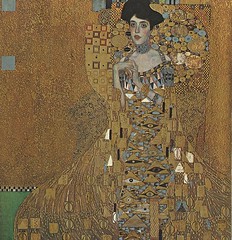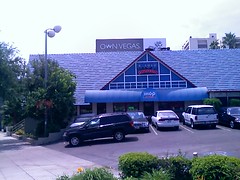A few months ago, Mary and I were lucky enough to see the Bloch-Bauer Klimts while they were on temporary display at the Los Angeles County Museum of Art. The linked news story gives the details, but these are the famous Klimt paintings that were recently returned to the Austro-Jewish family who had originally commissioned them, only to see them stolen by first the Nazis and then the Austrian government. The family had ended up in Los Angeles, and so while sale of the paintings were arranged, they were on display for free at LACMA. The centerpiece of the collection, a portrait of Adele Bloch-Bauer, was then purchased by a wealthy collector for a museum in NYC, where my mother and sister just went to go see it in its new home.
Although glad to see them in a museum open for public viewing, it saddens me to see these paintings leave Los Angeles. LACMA and other area museums attempted to put together a bid for them, but LACMA is not a wealthy institution, and it never came together. It is too bad, because having the painting here would have been a tangible link to one of the most important stories of Los Angeles: the emmigration of many important European artists to the area in the 1930s and 1940s: Igor Stravinsky, Arnold Schoenberg, Thomas Mann, Rudolf Schindler, Aldous Huxley...many others I can't think of at the moment. The Bloch-Bauers, like so many other Jewish families, ended up in Los Angles having fled Hitler. Ironically, their lawyer in the lawsuit to regain the paintings was a grandson of Schoenberg.
It's not that this period is not famous, or that it isn't given proper importance in histories and whatnot. It's just that, like so much of Los Angeles history, it seems like this rather amazing period went by without leaving any kind of tangible trace on the city. The most obvious trace left behind is a number of modernist structures, like the Schindler house and the Case Study houses. And UCLA and USC each have buildings named after Schoenberg, who grumpily taught intro music theory at both institutions. And there are quite a few well-known novels by these artists, complaining of their time in Los Angeles with themes that can be summarized as, "oy, the constant sunshine!" Down the street from me is an IHOP which some friends and I believe was one of Stravinsky's favorite haunts later in his life--we know that he spent a lot of time at an IHOP, and since this IHOP is near to where his house was, and has been in that location for many decades, it seems like a good possibility. I love thinking of Stravinsky sitting there, eating his waffles or whatever, and dreaming up The Rake's Progress. Update: This IHOP was built after Igor left Los Angeles. I'm going to ignore that fact. So there.
But I wish there was more. In so many cities, you have layers of history that you can feel as you walk the streets, or talk to people. You just don't have that feeling here. I know that this isn't how Los Angeles works, and that as the great postmodern city, I need to appreciate it on postmodern terms. But as I watch buildings go up and down, and people move in and out, I can't help wishing that more people and things would leave something behind.
Sunday, July 16, 2006
Subscribe to:
Post Comments (Atom)


1 comment:
Don't forget Brecht, who left Germany and was grudgingly writing plays against Fascism and even some Hollywood screenplays in LA, until he was called in front of HUAC and left the US immediately after testifying.
Post a Comment